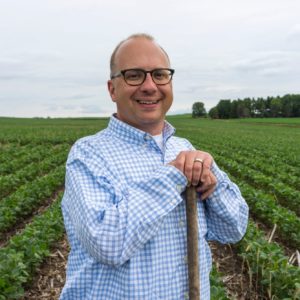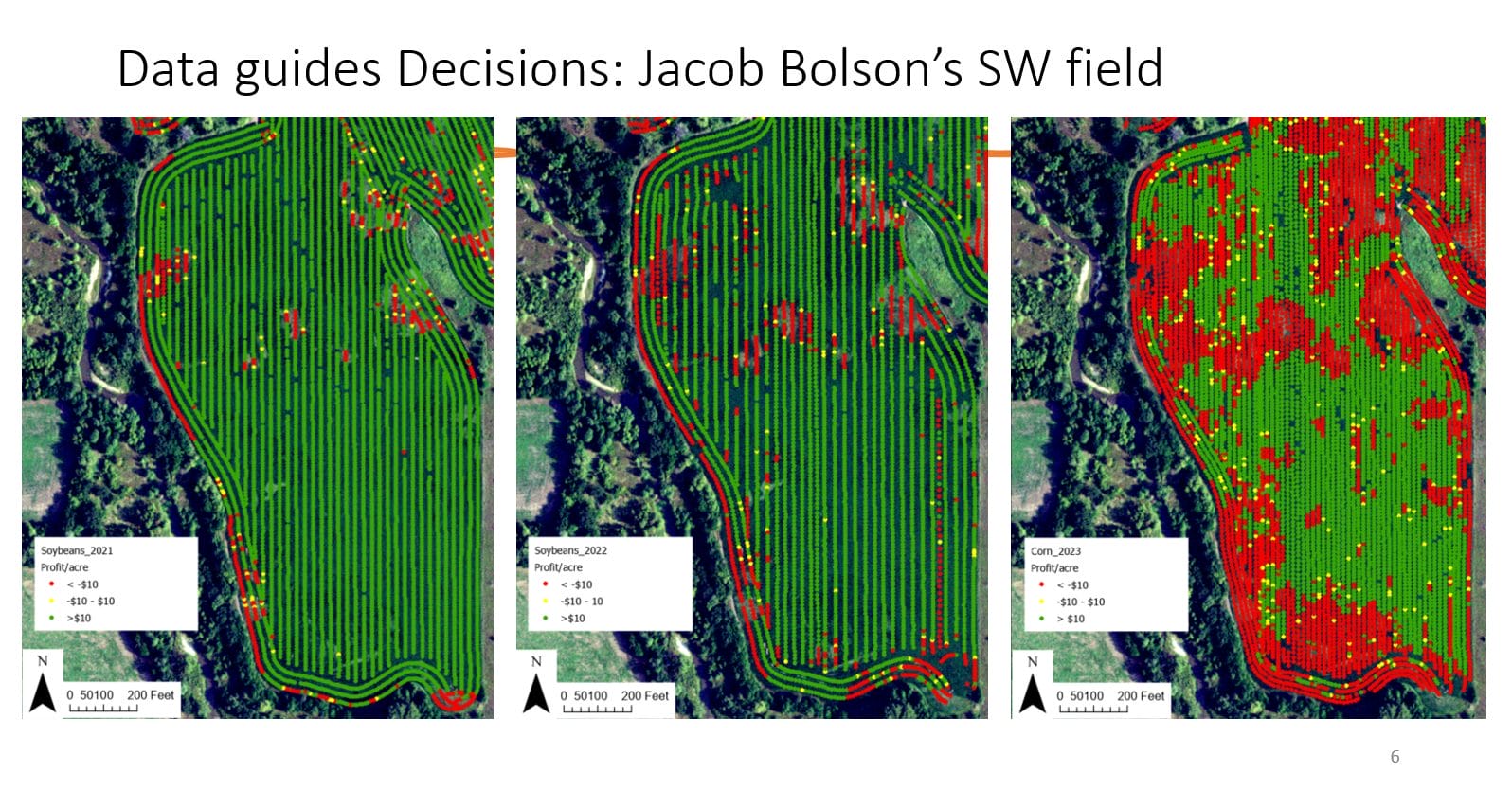Precision Conservation: Increasing Profitability and Conservation on Your Farm
 Jacob Bolson, his wife and four children are beginning farmers in Hubbard, Iowa. They rent the Hunt Farm, specializing in corn and soybeans, located just outside Eldora in Hardin County. They found their tenancy through Practical Farmers of Iowa’s Find a Farmer program and began working the acreage in the fall of 2020.
Jacob Bolson, his wife and four children are beginning farmers in Hubbard, Iowa. They rent the Hunt Farm, specializing in corn and soybeans, located just outside Eldora in Hardin County. They found their tenancy through Practical Farmers of Iowa’s Find a Farmer program and began working the acreage in the fall of 2020.
The Bolson family feels privileged to care for this century farm and have learned many lessons as beginning farmers, from seeding row crops and cover crops to establishing a tradition of conservation.
Diversity in Conservation
The first thing the Bolsons did upon getting approved and renting the farm in November of 2020, was to start sowing a cereal rye cover crop, knowing they planned to raise soybeans in 2021. The growth and termination of the cover crop bolstered the family, and, in the spring of 2021, Jacob began to plant the soybeans.
When he started sowing the soybean crop, Jacob followed the lay of the land in the southwest corner of the farm, sowing cover crops from fence row to fence row the way it was cropped historically.
“I got as close to the fences as possible, because I figured if that was where it had previously had crops, certainly I would want to continue raising crops on every possible square foot,” Jacob said.
Jacob soon learned, however, that getting seeding equipment right up against the fence line, so close to a tree line already, was a high-risk endeavor, especially as a beginning farmer and using rented equipment that did not belong to him.
Eventually, given a little more experience, Jacob began to wonder why he was trying so hard to plant fence row to fence row, given the challenges of avoiding fallen branches and scratching equipment, but he had committed to the practice and sowed the rest of the fields in the same way.
Then came the harvest of fall 2021. “I hired a family member to help me harvest the beans in the fall, and we were combining along these fence rows and tree lines, and I didn’t even have to look at the yield monitor to realize that the yield wasn’t very good,” Jacob said. “The yield along the fence lines was practically zero.”
To break up rootworm pressure from long-term corn on corn, Jacob decided to do a second year of cereal rye cover in the fall of 2021, followed by soybeans in the spring of 2022, only this time, Jacob offset his planter by 15 feet from the fence line, creating a buffer and making the planting of his cash crop of soybeans easier to seed in the spring. The yield for areas that had been given a buffer had noticeably better yields than the year before, and Jacob realized he was onto something.
Embracing Change
As the 2022 planting and harvest of soybeans wrapped up, Jacob noted that while his yields had improved with the 15-foot buffer, they were still below profitable margins. The same results followed the 2023 harvest of corn.
“There was still enough pressure of sunlight from the tree line that wraps around the fields as well as the trees pulling moisture out of the soil, and I realized that a 15-foot offset was not enough,” Jacob said.
Realizing that the impact from the trees and sandy soils closer to a nearby creek necessitated a larger buffer, Jacob contacted his local NRCS office, and with their help, enrolled in the Conservation Stewardship Program. This spring (2024), Jacob will be using that program to place a 30-foot pollinator habitat where the original buffer was but expanded. Utilizing a native seed box drill, he will place approximately 2-acres into pollinator habitat, most of which will be in the southwest corner of the farm.
“I’m going to be outlining my whole southwest field in a 30-foot buffer because I learned in 2021, 2022 and 2023 that farming up to the fence row just doesn’t work,” Jacob said. “Even offsetting by 15-feet is still not enough to have a return on my investment in terms of yield do correlate to the inputs I’m providing.”
Empowered by the new pollinator habitat, Jacob has decided to integrate other conservation practices on the farm. Hunt Farm is a diverse farm in terms of soil type and has two wetlands and two creeks, one being Beaver Creek, flowing through it as well as a livestock pasture.
Other conservation efforts included the installation of two wood chip bioreactors in June of 2022, by the Southfork Watershed Alliance and the Iowa Department of Agriculture and Land Stewardship. Jacob has also adopted a hybrid strip tillage and no-tillage system of row cropping.
“We are also taking a few additional tillable acres out of production and putting those into a long-term CRP [Conservation Reserve Program] with the NRCS,” Jacob said. “We’ve got a lot of work going on out here to improve the care and stewardship of the land.”

These maps show the profit drag Jacob observed along the tree line. This challenge led him to create and implement his own precision conservation plan to transform those unprofitable acres into pollinator habitat. These maps were created by Stephanie Nelson of Pheasants Forever using Jacob’s yield data shown in dollars per acre, calculated with ISU statewide average cost of production and market price data (not Jacob’s actual cost of production records).
Using Analytics in the Adoption of Conservation Practices with Pheasants Forever
Jacob took the necessary steps by himself to analyze his yield data and make a change based on what he was seeing in the data and in his field observations. With that data, he was able to implement his own precision conservation project, but landowners can also work with PFI’s partner organization, Pheasants Forever, to improve farm profitability while creating habitat on their land.
Through this free service, a precision agriculture and conservation specialist, like Stephanie Nelson, will analyze farm data to pinpoint marginal acres and draft a plan to transform those acres into vibrant habitat. An incentive is available for farmers in Iowa and Minnesota who make a change based on this precision conservation process. Reach out to Stephanie at snelson@pheasantsforever.org or (712) 266-3977 for more information.
